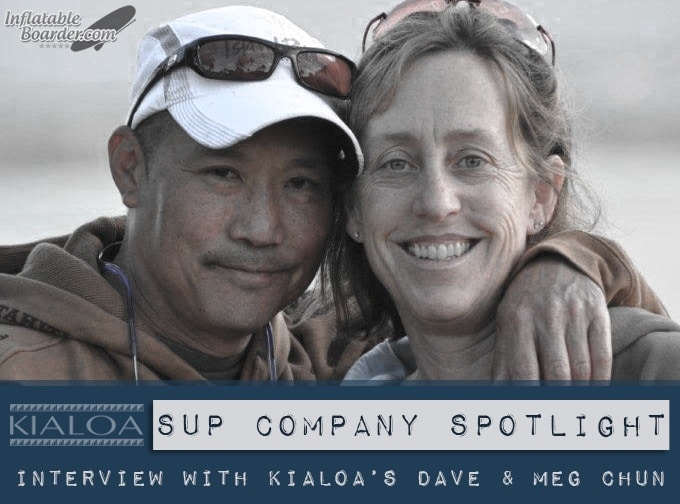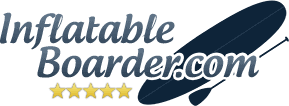
In this latest edition of SUP Company Spotlight, we caught up with KIALOA founders, Dave and Meg Chun. Well-known for their popular lineup of premium paddles, KIALOA is a company that places a high-priority on excellence, teamwork, and stewardship…
How were you initially introduced to the sport of stand up paddleboarding?
Laird Hamilton was the person who introduced KIALOA Paddles to SUP. He told me he needed a 6-foot-long paddle.
Laird was in the beginning stages of experimenting with SUP. The sport didn’t have a name when we first spoke. Gerry Lopez had shaped Laird one of the first SUP specific boards, and he told Laird he should give me a call about a paddle. It was 2003, I had been building outrigger paddles for 12 years and had a background in woodworking and composites. I hand shaped the first one-off paddle from wood and reinforced the shaft with carbon fiber.
I didn’t know if the paddle order would be a one-off transaction, or lead to more orders. I just looked at it as a challenge, because when I asked him why he was not ordering another one from the guy who had built his previous paddles, he told me “I broke all of them”.
Laird didn’t break the paddle and he placed an order for more. Because of the large number in the order, I built a mold for a carbon fiber blade and used an aluminum shaft. As Laird’s notoriety brought in more orders, we built a tool to construct carbon fiber shafts.
What ignited the spark in you both to get involved in the industry?
When we started there was no industry. We were simply building a paddle for a customer.
Since the beginning of KIALOA in 1991, Meg and I have focused on listening to paddlers and building what they need. Outrigger paddling is raced based. As such, performance-based paddle design was something we were familiar with. The only difference in SUP was calculating the different stresses created with the standing position and developing the blade and shaft design as the athletes and the different disciplines of SUP evolved. Surfing was the first SUP discipline. Racing was the next. Recreational paddling and white water occurred later. With each new discipline came new requirements for paddle design.
In many ways, the progression of the sport was what made SUP appealing. Pioneer big wave surfer, George Downing once told me, “If you wake up in the morning and you have something to do, that’s a good day”. I like George and I like having something to do.
How important have good employees been to your success?
Good employees have been essential to the growth of KIALOA through the quarter century plus of our existence. But, we have also implemented a business plan and structure where employees are able to reach their full potential because we are all working towards a common goal.
All healthy businesses are a combination of clear organizational planning, management, and skilled employees who have defined job descriptions and measurable goals.

*KIALOA’s Insanity Adjustable 3-piece Paddle
If you had a chance to start KIALOA over again, what would you do differently?
I once heard Yvon Chouinard, founder of Patagonia Clothing, say: “Profits are only one measure of a company’s success”. There are certainly things Meg and I could have done to have grown KIALOA into a larger company. But in doing so, it would have moved us away from our core goal. We started KIALOA as a craft business in the backyard of my parent’s home in Kailua, Hawaii. What interested us was building paddles. The focus of a craftsmen is not one of accomplishment in the monetary sense, but joy in one’s craft. We in a sense, are a throwback to a time where if someone’s name was Shoemaker, you knew what they did for a living. We are passionate about building paddles and are grateful for the intimate relationships we have with our customers. So, while there are financial opportunities we missed along our journey, we would not change our decisions if it was at the expense of the lifestyle and relationships we have made. Meg and I lead a modest life and we are grateful for the lifestyle KIALOA has provided us. Simply put – No regrets.
What have been some of your failures, and what have you learned from them?
Failure and products: We start new projects building multiple prototypes and utilize field testing to evaluate performance. We rarely have an outright failure if we follow procedures. Our product development loop begins with identifying a paddle need, and we build to that spec. We have a pretty good idea entering a project if sales will be high for the model, or if it is filling a smaller but necessary niche in the market. Lower sales on a model do not always mean failure to us if the model fills a need for the paddling community.
Failure and business: We view failures or problems as a component of business. We follow the philosophy of Toyota a.k.a. Lean Manufacturing. Problems are indicators of where the system needs to improve. This being the case, small course corrections dealt with immediately help to avoid catastrophic events.
How many hours a day do you both work on average, and what does your typical day look like?
Dave: I don’t keep track of the number of hours I work. I recently visited Tahiti to gather product information and test our V-1 canoe paddles. The Tahitians are the best paddlers on Earth, and there is no better location for paddling research. But I also tasted Bordeaux wines and visited with an authority on Paul Gauguin. The line between work and play is blurred.
I travel approximately 30% of the year as a key element of my work is to keep abreast of what is happening in paddling. I enjoy traveling to races speaking with elite as well as novice paddlers. I aggregate the feedback and translate the ideas into our products.
When I am home, I typically get to the shop at 4:00 am. I work for a few hours and then I exercise. I view training as an essential component in my work. It nurtures the intimate relationship between myself as a product user and a designer. It is motivating to design equipment I will eventually use. I paddle SUP, outrigger, and surf ski. I also rock climb, mountain bike, weight lift, spearfish, fly fish, and surf, as I feel it is important to expand my kinesthetic awareness. When I return to the shop, I work as much or as little as needed. I do this 7 days a week. This summer my task is to learn to downwind SUP foil on the Columbia Gorge. Is this work or play?
Meg: Meg works a more traditional work day. As the leader of KIALOA, Meg interacts with more people, on a greater variety of topics, which leads to less flexibility in her schedule. Though highly organized and efficient, the scope of her work adds up to a tremendous time commitment. Meg has an office at home as well as at the shop; and with meetings, volunteer work and involvement on various business boards of director, she works all hours of the day.
Meg has been an avid outrigger racer since we met at Kailua Canoe Club in the 1980’s. She continues to be a driving force in the Bend Oregon Canoe Club, a club we founded when we moved from Hawaii to Bend, Oregon in 1992. During the summer months, Meg paddles surf ski or outrigger in the morning or evening. And on as many weekends as possible, downwind paddles in the Columbia Gorge, where she stores one of her outrigger canoes. In the winter she cross country skis before work and on weekends.
What motivates you, and who has been your greatest inspiration?
Outrigger paddling culture is the greatest inspiration in our lives. KIALOA is guided by three Hawaiian values: Po’okela – Excellence, Laulima – Cooperation, and Malama – Stewardship. These were lessons taught to us by our coaches at Kailua Canoe Club. Because of this, we are eternally grateful to the sport. It could be argued that our lives revolve around outrigger and paddling in general.

How do you define success?
Contentment with one’s life. Well, I try to…
I can’t completely get away from defining success as a monetary measure. In the context of financial success, we are middle class America. For 20 plus years I have belonged to a health club where the Bend, Oregon, business professional are members. The typical locker room talk is about real estate deals, exotic vacations, and Porsches. Talk like this makes me feel unsuccessful. But my locker room friends are quick to point out how envious they are of my globetrotting sport focused life and fitness level. I have prioritized health over wealth. They have prioritized wealth over health. Who is the more successful?
When asked what surprised him most about humanity, the Dalai Lama responded: “Man. Because he sacrifices his health in order to make money. Then he sacrifices money to recuperate his health. And then he is so anxious about the future that he does not enjoy the present; the result being that he does not live in the present or the future; he lives as if he is never going to die, and then dies having never really lived.”
What do you enjoy most about being involved in the SUP industry?
Meeting new people. SUP has introduced participants who have no interest in paddling a canoe or kayak but are curious about trying a SUP.
SUP also provided KIALOA the opportunity to introduce FibrliteTM composite construction to single bladed paddle sports. FibrliteTM is a continuous fiber reinforced thermoplastic which has exceptional durability, light weight, and is more eco-friendly than traditional fiber/epoxy systems. The resin system used in our FibrliteTM paddles is 100% post industrial recycled polypropylene. The niche markets of outrigger and dragon boating alone did not allow a project like FibrliteTM to be feasible.
Where do you see the paddleboarding industry in 10 years? 20 years?
The largest growth segment in SUP is the recreational market. People who view SUP as a secondary activity or something to do on a vacation through a rental service.
We have always been committed to building the best paddles at any price level. No matter if it is a beginner, occasional user, rental customer, or a seasoned pro, we are committed to building the best paddle to fit the end user’s needs. However, we are steadfast in our belief that cheap “disposable” paddles which sink or are so poorly constructed that they break with minimal use, are nothing but a black eye for our sport and the environment. SUP is a plastic industry. And the only way we can reduce our carbon footprint is to make goods which last a long time. Give your used paddle to a newbie, sell it on Craigslist, but the last thing we want is to have cheap poorly constructed paddles littering our landfills.
